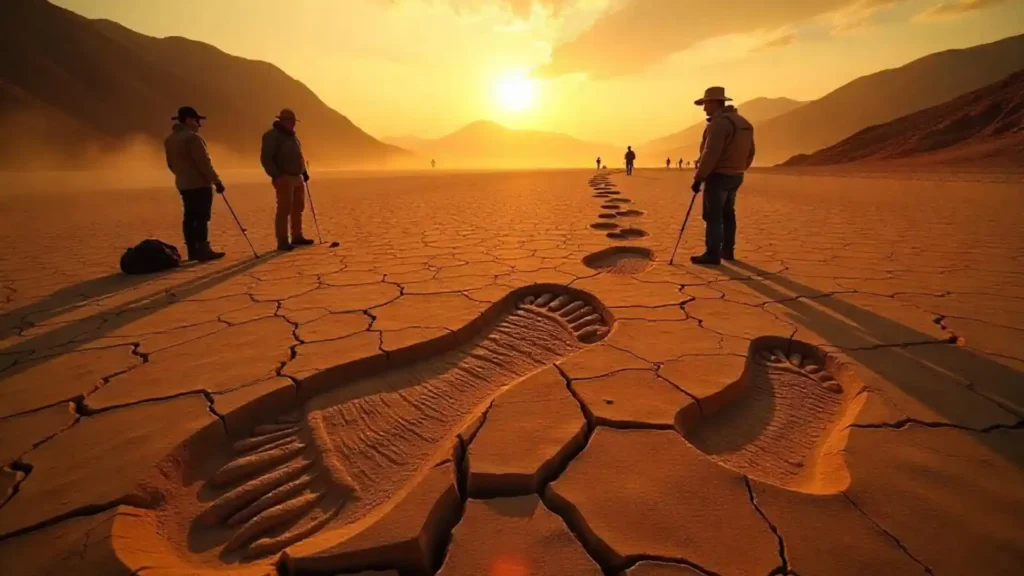Giant footprints in the Atacama Desert have sparked international curiosity, challenging our current understanding of prehistoric life.
Category: Archeological Discoveries
Giant footprints in the Atacama Desert baffle scientists
Located in one of the driest and most desolate places on Earth, these massive imprints have drawn attention not only for their size but also for their unusual depth and arrangement across an ancient rock plateau. These tracks appear far too large to belong to any known animal or hominid, prompting experts to re-evaluate theories about ancient species in South America.
Surprisingly, early estimations suggest that the footprints could date back several thousand years. Yet, no known South American creature matches the dimensions or gait of the imprints. As more data emerges, scientists are beginning to dig deeper into the layers of time that conceal the origins of these enigmatic tracks.
Giant Footprints in The Atacama Desert: A Silent Witness of Time
The driest desert holds prehistoric secrets
The Atacama Desert, stretching across northern Chile, has long been a site of fascination due to its Mars-like terrain and ancient geoglyphs. Now, it adds another mystery to its legacy: colossal footprints embedded in prehistoric sediment. While local legends have whispered tales of “giants” roaming the land, scientific inquiry aims to ground these myths in tangible evidence.
Because the arid climate preserves geological formations remarkably well, the footprints have remained intact despite their age. This preservation provides researchers with a rare opportunity to study a specimen untainted by erosion, offering critical insight into the world as it was millennia ago.
Paleontologists step into the mystery Giant Footprints
Fossil experts examine the impossible
Paleontologists began their investigation with cautious optimism. First, they ruled out hoaxes and modern interventions. Next, they analyzed the stride length, toe impressions, and the depth of the footprints to determine biological feasibility. The results were startling. The foot structure suggested bipedal movement, yet the size indicated a creature potentially over 12 feet tall.
Additionally, the angle and pressure of the impressions indicated a weight far beyond that of Homo sapiens or any known animal from the region. Dr. Lucía Fernández, a renowned Chilean paleontologist, remarked, “We are either looking at an undocumented species or evidence of something that defies our conventional timeline of evolution.”
Unearthing clues beneath the surface
To get closer to the truth, researchers drilled core samples beneath several prints. Carbon dating and sediment analysis revealed that the ground was last disturbed approximately 9,000 years ago. This would place the footprints in the early Holocene epoch, a period thought to be dominated by smaller mammals —not giants.
Furthermore, the mineral composition of the surrounding rock showed signs of sudden compression, which could indicate an impact or an intense force during the creation of the prints. Despite exhaustive testing, researchers have yet to identify any known species that fits all variables.
Geologists decode the Earth’s memory
Ground pressure tells a different story
Geologists quickly joined the effort, measuring ground pressure patterns and soil displacement. According to lead geologist Dr. Mark Rivkin, the density of the impressions indicates a dynamic event. “This isn’t erosion or a mere anomaly,” he stated. “The pressure is consistent with a large bipedal organism walking naturally, not jumping or falling.”
By using ground-penetrating radar, scientists created 3D models of the footprints and surrounding terrain. These models were compared with known fossils and environmental conditions from that era. The results further deepened the mystery, suggesting that the environmental conditions at the time could have supported large organisms—but none were known to exist.
Climate shifts may offer critical insights
Since the early Holocene saw significant climate shifts, researchers explored whether these changes could have supported unknown megafauna. Some ancient ecosystems in the region supported creatures like giant ground sloths and prehistoric camelids. However, none of these species match the dimensions or structure of the footprints found in Atacama.
The environmental data offers a tantalizing possibility: perhaps an undocumented migration occurred, or an unknown evolutionary offshoot existed briefly before vanishing without fossil evidence. Learn more about extinct megafauna in this external research archive from the Natural History Museum.
Giant Footprints: The role of local legends and cultural memory
Indigenous stories hint at ancient beings
Giant footprints in the Atacama Desert have long featured in the oral traditions of local Atacameño communities. According to folklore, sky beings or “Los Gigantes del Sol” once walked the desert. While mainstream science often dismisses such stories, anthropologists suggest these tales may preserve distant memories of real prehistoric events or species.
Ancient rock art and geoglyphs in the nearby Pampa del Tamarugal also depict large humanoid figures. Some of these geoglyphs span over 100 feet and resemble figures walking in the same direction as the footprints. This alignment has not gone unnoticed by cultural historians, who now work alongside scientists to integrate indigenous perspectives into the investigation.
Could cultural memory be a fossil of its own?
If oral history can echo events from thousands of years ago, then it may serve as an alternate form of fossil—preserving snapshots of ancient life through narrative. The fusion of cultural memory and scientific inquiry adds a new dimension to the case, suggesting that solving this mystery requires more than just data. Explore our detailed breakdown of ancient storytelling and science in our internal article on myth and memory in archaeology.
What comes next for the Atacama enigma?
New technologies promise fresh breakthroughs
Future expeditions plan to use LiDAR scanning, isotope testing, and AI-assisted analysis to build a more comprehensive understanding of the footprints. International collaboration between universities in Chile, Germany, and Japan has formed a specialized task force to continue the investigation over the next five years.
By layering diverse scientific disciplines, researchers hope to reach a conclusion that respects both empirical evidence and the cultural roots of the mystery. The Atacama footprints might not just rewrite our understanding of ancient biology—but also our appreciation for the ancient human imagination.
Curious about more unsolved archaeological mysteries? Subscribe to our newsletter for exclusive updates and behind-the-scenes access to ongoing discoveries.
Artikel Paling Seru : Winter Activities in Canada That Will Make You Love the Cold


